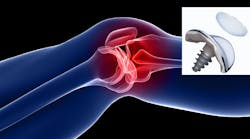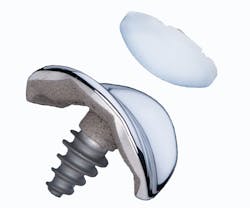Redesigned Knee Joint Replacement Lets Patients Stay Active
About 91 million Americans, including one-third of working-age adults, suffer from arthritis. To treat the chronic and painful orthopedic conditions caused by arthritic disease, more than a million knee and hip replacement surgeries are performed in the U.S. annually. Although most of these surgeries are traditional total-joint replacements, the prevalence of less invasive, joint-preserving procedures continues to increase in volume and preference.
Unfortunately, clinical studies suggest that 1 in 5 total knee replacement patients continue to have long-term, chronic joint pain after their surgery.
For younger and more active patients who have had knee replacements, long-term restrictions on postoperative activities make the procedure less-than-ideal. Additionally, revision surgeries are more complex and time-consuming, and often require specialized implants and tools to compensate for the substantial bone and soft tissue damage caused during and after the original surgery. Moreover, the younger the patient, the more revision surgeries they will likely need as the prosthetic wears out and the patient ages.
Traditional knee replacements begin by removing the entire joint along with surrounding structures such as ligaments and tendons. This is followed by inserting a stem into a hollow spot in the long bones. Traditional replacements rely on a press fit or cement to keep them firmly fixed in the new joint over a long period of time. However, that isn’t the way our bodies naturally pass the load through to a healthy joint. Surgery completely changes the joint’s anatomy, so patients’ bodies must adapt and function differently. And because joint replacements are designed to shield the bone from the load, the body adapts by resorbing some of the bone and making it more fragile.
Over the past two decades, improvements and innovations in joint restorations and the trend toward less-invasive surgical techniques have led to a growing adoption of joint-preserving procedures, such as hemiarthroplasty and stemless inlay arthroplasty.
Until now, younger and active patients had no really good options. They suffered chronic pain severe enough to limit their lifestyle and daily activities. But they were caught in the middle: their pain could no longer be helped by sports medicine or traditional arthroscopic procedures, and they were too young or too active to be good candidates for total joint replacements. Their only option was to give up their active lifestyles and wait until they were 55 or 60 years old to get a replacement.Here is one of PF Wave Arthrosurface’s knee joint implants.
With the help of orthopedic surgeon Dr. Anthony Miniaci from the Cleveland Clinic’s Center for Sports Health, Arthrosurface Inc. designed a knee implant—the HemiCap—that replaced only the damaged area of the joint while preserving the majority of the healthy joint. Benefits of this new HemiCAP implant include:
Providing a long-term treatment option for younger and more active patients suffering from severe, chronic knee pain. The HemiCAP is designed to be implanted in a minimally invasive surgical procedure that, unlike a traditional joint replacement, can be performed on an outpatient basis with significantly shorter rehabilitation and recovery times. There are no long-term postoperative activity restrictions. In addition, the implant preserves all the healthy bone and tissue in the knee, so if the hardware needs to be revised or removed, a traditional total joint replacement can be easily performed as if the interim implant had never been there.
Preserving the joint’s native anatomy and restoring a new load-sharing surface. The implant’s glenoid shoulder implants are inlays that are load sharing devices, not load bearing. They pass most of the load into the bone by replicating the body’s natural biomechanics. This preserves and restores the joint’s original anatomy and lets patients resume load-bearing activities that thicken and strengthen the bone.
Being made of raw materials with no microstructural flaws let the implants be about one-third thinner and significantly lighter. It also uses a more stable and immobile fixation element, a Morse taper. The taper posts (screws) provide a strong, stable interlock between the taper post and cap. The thread of the taper posts also helps pass the loads into subchondral bone, so the load becomes a triangle of loads that form into the bone.
Fitting a custom implant in a single procedure. To provide a custom fit, the doctors must figure out early on how to recreate the existing geometry of the joint. The designers made it easy for doctors to map the surface curvature of the knee joint with 3D mapping software and send that data directly to one of the Arthrosurface manufacturing machines, letting them make an individually custom-fit implant that matches the patient’s joint surface.
The challenge was finding a way to make the implant a single-surgery procedure, unlike the expensive, individually cast, patient-specific custom implants that require two procedures, prep, and diagnostic work. The solution was to make HemiCAP implants in a range of sizes, convexities, and curvatures. This ensures the final implant is sized and contoured to the patient’s joint size and shape. This means the surgical team goes into every implant procedure with every size of implant so it can select the right implant for a perfect fit.
It’s like being able to find a shoe that fits perfectly by going into an extremely well-stocked shoe store that carries every size and width and leaving with exactly what you needed, rather than having a custom-fit pair of shoes individually made to order—which can be expensive and requires several visits.
In follow-up studies, Arthrosurface’s implants have been clinically proven to help patients stay active by reducing pain, increase range of motion, and substantially improve postoperative activity levels. Patients have no long-term physical restrictions after surgery, and most can resume both moderate and strenuous sports activities.
For example, Boston triathlete Letia Payne chose a Patellofemoral (PF) Wave Implant instead of a traditional total knee replacement on the recommendation of Brian McKeon, M.D., her orthopedic surgeon at New England Baptist Hospital. Within a few months of her procedure, Payne had resumed all her triathlete activities.
In addition to this and other success stories, a clinical study also showed that two years after patients got an Arthrosurface knee implant, the degenerative changes to their joints were slowed or halted. If additional clinical studies confirm that the implants can not only postpone the need for a traditional total joint replacement, but can stop the progression of joint disease, that could dramatically shift the clinical thinking around orthopedic surgery and increase the focus on the life-changing benefits of joint preservation technology.


